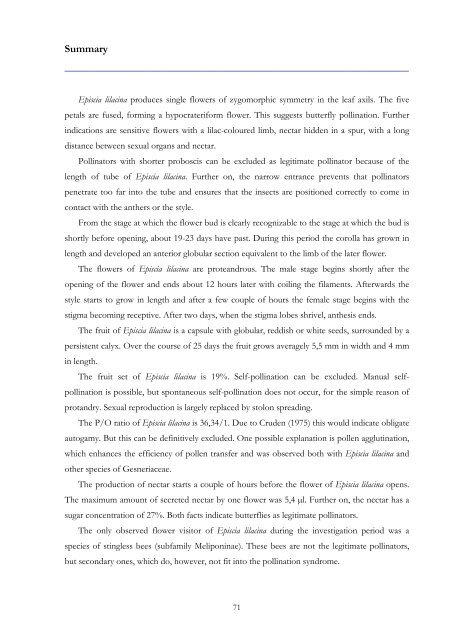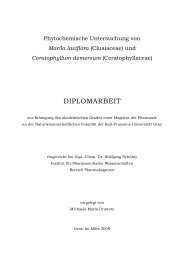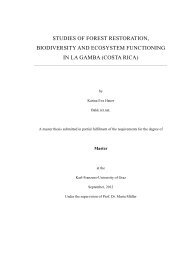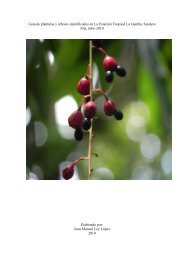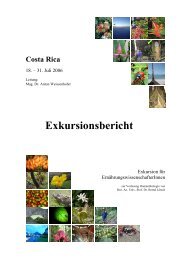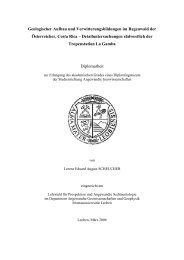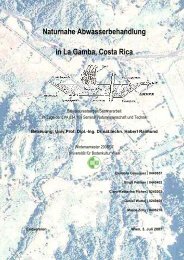Leaf colour patterns, vegetative and sexual reproduction of Episcia ...
Leaf colour patterns, vegetative and sexual reproduction of Episcia ...
Leaf colour patterns, vegetative and sexual reproduction of Episcia ...
Create successful ePaper yourself
Turn your PDF publications into a flip-book with our unique Google optimized e-Paper software.
Summary<br />
________________________________________________________________<br />
<strong>Episcia</strong> lilacina produces single flowers <strong>of</strong> zygomorphic symmetry in the leaf axils. The five<br />
petals are fused, forming a hypocrateriform flower. This suggests butterfly pollination. Further<br />
indications are sensitive flowers with a lilac-<strong>colour</strong>ed limb, nectar hidden in a spur, with a long<br />
distance between <strong>sexual</strong> organs <strong>and</strong> nectar.<br />
Pollinators with shorter proboscis can be excluded as legitimate pollinator because <strong>of</strong> the<br />
length <strong>of</strong> tube <strong>of</strong> <strong>Episcia</strong> lilacina. Further on, the narrow entrance prevents that pollinators<br />
penetrate too far into the tube <strong>and</strong> ensures that the insects are positioned correctly to come in<br />
contact with the anthers or the style.<br />
From the stage at which the flower bud is clearly recognizable to the stage at which the bud is<br />
shortly before opening, about 19-23 days have past. During this period the corolla has grown in<br />
length <strong>and</strong> developed an anterior globular section equivalent to the limb <strong>of</strong> the later flower.<br />
The flowers <strong>of</strong> <strong>Episcia</strong> lilacina are prote<strong>and</strong>rous. The male stage begins shortly after the<br />
opening <strong>of</strong> the flower <strong>and</strong> ends about 12 hours later with coiling the filaments. Afterwards the<br />
style starts to grow in length <strong>and</strong> after a few couple <strong>of</strong> hours the female stage begins with the<br />
stigma becoming receptive. After two days, when the stigma lobes shrivel, anthesis ends.<br />
The fruit <strong>of</strong> <strong>Episcia</strong> lilacina is a capsule with globular, reddish or white seeds, surrounded by a<br />
persistent calyx. Over the course <strong>of</strong> 25 days the fruit grows averagely 5,5 mm in width <strong>and</strong> 4 mm<br />
in length.<br />
The fruit set <strong>of</strong> <strong>Episcia</strong> lilacina is 19%. Self-pollination can be excluded. Manual selfpollination<br />
is possible, but spontaneous self-pollination does not occur, for the simple reason <strong>of</strong><br />
prot<strong>and</strong>ry. Sexual <strong>reproduction</strong> is largely replaced by stolon spreading.<br />
The P/O ratio <strong>of</strong> <strong>Episcia</strong> lilacina is 36,34/1. Due to Cruden (1975) this would indicate obligate<br />
autogamy. But this can be definitively excluded. One possible explanation is pollen agglutination,<br />
which enhances the efficiency <strong>of</strong> pollen transfer <strong>and</strong> was observed both with <strong>Episcia</strong> lilacina <strong>and</strong><br />
other species <strong>of</strong> Gesneriaceae.<br />
The production <strong>of</strong> nectar starts a couple <strong>of</strong> hours before the flower <strong>of</strong> <strong>Episcia</strong> lilacina opens.<br />
The maximum amount <strong>of</strong> secreted nectar by one flower was 5,4 µl. Further on, the nectar has a<br />
sugar concentration <strong>of</strong> 27%. Both facts indicate butterflies as legitimate pollinators.<br />
The only observed flower visitor <strong>of</strong> <strong>Episcia</strong> lilacina during the investigation period was a<br />
species <strong>of</strong> stingless bees (subfamily Meliponinae). These bees are not the legitimate pollinators,<br />
but secondary ones, which do, however, not fit into the pollination syndrome.<br />
71


